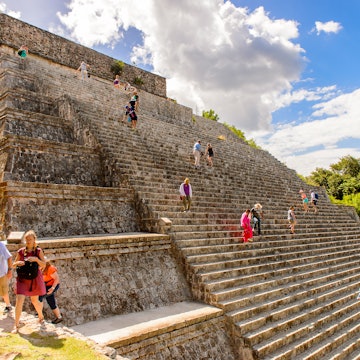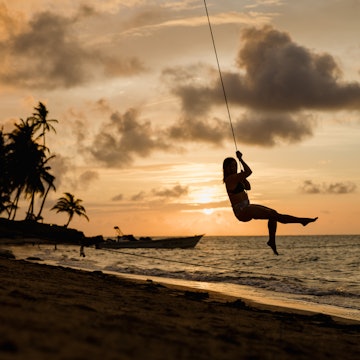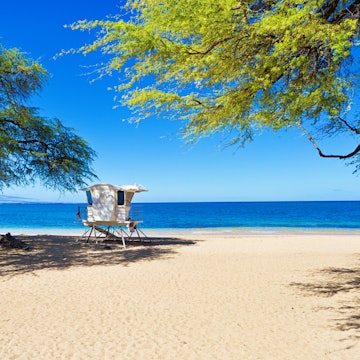

Palacio de Bellas Artes in Mexico City. SHEE HENG CHONG/Shutterstock
With a population of over 21 million people in the wider area, Mexico City is a densely packed metropolis with Indigenous origins dating back to the 1300s, when it was called Tenochtitlán.
This beautiful yet chaotic city is my hometown. After a lifetime in CDMX (as it's often referred), I am still surprised by the sense of community and how locals – known as chilangos – own and enjoy public spaces such as parks and plazas. People watching is a pastime here, and going out for the sake of walking around and having a late-night snack is a form of entertainment.
In recent years, Mexico City has become a sought-after destination for travelers seeking to indulge in Mexico's rich culinary heritage, admire the city's stunning architecture and stroll around the picturesque neighborhoods such as Juárez, Roma and Condesa, and Polanco.
Yet throughout my years as a travel writer and fixer in Mexico, I still hear questions that reflect particular misconceptions about the city. So here are some answers to help you plan a trip to Mexico City and feel more confident and at ease when you arrive.

1. What should I pack for Mexico City?
Mexico City is privileged in the weather department, since it enjoys a consistent temperature averaging 20–25°C (68–77°F) most of the year. Summer is considered the rainy season; it will likely rain during the evening from late June until mid-October, either a massive 20-minute downpour or just a sprinkle here and there, but rest assured, it will rain.
Pack a light, waterproof jacket, but skip the umbrella. If you get caught in the rain, street vendors sell umbrellas for 60 Mexican pesos (M$) on average. Pack comfortable shoes – you might do lots of walking as you explore the city. Bring a button-down shirt or a summery or casual dress if visiting high-end restaurants. Chilangos tend to be dressier and chic when going out.
2. How long should I stay?
Plan a 4- or 5-day trip to have enough time in the city's most popular neighborhoods and at the top attractions. If you wish to visit Teotihuacán – an archaeological site located 39km northeast of Mexico City – or Xochimilco's Cuemanco ecological area in the southern part of the city, set aside an entire morning for each activity, since it can take around 90 minutes to reach each destination when coming from the central areas of the city.
The Museo Nacional de Antropología and the Castillo de Chapultepec deserve at least 4 or 5 hours of your time. Allow a full day to walk around Centro Histórico (Mexico City's downtown area), visiting sites such as the Palacio de Bellas Artes, the Diego Rivera murals, the Catedral Metropolitana and Templo Mayor.
Give yourself some time to experience Mexico City's pace of life. It can be hectic but quiet enough to enjoy a coffee or a cocktail and unwind.

3. Some restaurants and tours should be booked months in advance
The Mexico City dining and bar scene is lively and includes some of the best restaurants in North America and the world. You should book a table well in advance if Pujol or Quintonil are on your list of places to eat.
If traveling to Mexico City with friends or family, it's worth making lunch and dinner reservations in advance because it will be harder for sought-after restaurants and bars to accommodate walk-ins of large parties.
Buy tickets to the Museo Frida Kahlo or Casa Luis Barragan plenty of time before you depart, and plan the itinerary of your trip around the reservations that are harder to get.
February to early May and September to December are usually the busiest months to visit Mexico City, so adjust accordingly if you prefer to avoid crowds.
4. Tip most service staff
Mexico City is a predominantly working-class city, and there is a lot of economic disparity in the service and hospitality industry. Consider a 15% tip as the standard and even 20% based on the full tab at restaurants, bars and coffee shops or the amount paid for tours and services.
Service staff at restaurants and bars will ask if you wish to add a tip before swiping your card. On the other hand, if you decide to take a tour or hire a city guide, tip with cash, preferably in pesos.
Tipping a rideshare driver is not common, but if you hire a personal chauffeur throughout your trip, tipping will be expected. If you visit a supermarket and someone assists you in packing your groceries, tip M$10–15.

5. Street food is delicious but not very accommodating
Veganism, vegetarianism, a gluten intolerance, food allergies, and religious or cultural-related food restrictions will be hard to accommodate in most places in Mexico City, especially when visiting street food stands.
Taco stands or quesadilla vendors might cook vegetarian dishes with lard or near animal proteins; some mole and salsas could have peanuts or other nuts. Most local markets have sections where traditional butchery is on full display. If you're a meat eater, be open to the idea and exercise a degree of flexibility. You might end up trying delicious Mexican food.
When visiting a taco stand, locals might warn you about the spiciness of the salsas, and it might be a bit more spicy than what you are used to. In Spanish, picante means spicy.
Mexican eateries – fondas – cook mostly from scratch and always have a vegetarian dish on the daily menu. Corn tortillas are everywhere in Mexico City, so you should be good to go if you need to eat gluten-free.
Most restaurants are mindful of food restrictions and allergies, and might make suggestions based on their current menu. But expect them to keep a dish the same, accommodating your request in the best way possible.
6. Mexico City is not inexpensive
If you earn your income in US dollars, euros or British pounds, your travel budget will go further in Mexico City than, for example, New York, Paris or London. However, Mexico City is not inexpensive for Mexicans, and the cost of living has risen considerably for locals in the past five years, especially for housing, due to short-term rentals. Chilangos are generally welcoming and hospitable, but comments from tourists about the lower relative costs in the city are unlikely to be appreciated.

7. Is Mexico City safe?
The answer to this question really depends on where you are coming from. Strolling around central neighborhoods like Roma, Polanco, Coyoacán and Condesa is much safer than walking, for example, in certain areas of US cities such as San Francisco, Philadelphia, Phoenix, LA, Chicago and Washington, DC. Mexico City's government has increased security patrols in most areas, and overall, the city is safe.
As in any major city, be aware of your surroundings and always be mindful of your belongings. Watch out for petty crime and pickpockets in tourist areas. If you end up in a crowded place like a stadium, concert or music festival, keep your valuables close to you. Leave any flashy jewelry or watches at the hotel.
If taking public transportation like the Metro (as the subway system is called) or buses, be aware of pickpockets. It's probably best to avoid taxis you hail on the street and opt for a rideshare like Uber instead.
There are, for sure, neighborhoods in Mexico City where even residents advise caution, so always refer to local intel if you are planning to explore the outer areas of the city. If an area feels edgy and unsafe, staying away is best.
8. Can I drink the water?
A good rule of thumb is that you can brush your teeth, but do not swallow any water. Depending on the city borough, the quality and sanitation of the tap water might change. Consequently, Mexico City residents drink only filtered or bottled water.
Since 2014, restaurants have been required by local authorities to serve filtered water to consumers at no extra cost. Any ice used to prepare drinks, aguas frescas (fruity beverages) and cocktails is made with filtered water. Coffee shops and juice stands prepare beverages with filtered water as well.

9. Stay hydrated to help with the altitude
Mexico City sits in a valley in the high Mexican central plateau, at an elevation of 2240m. You might notice you are more tired than usual a day or two after your arrival. Drink enough water and stay hydrated at all times. You might also experience that alcohol hits you faster here. It is all because of the high elevation.
Luckily, you can find bottles of electrolytes in every Oxxo or 7-11 store. Locals call them electrolitos, and once you recognize the bottles, you will catch them everywhere. Electrolitos come in different flavors – coco, lime, strawberry – and are great for curing a hangover.
10. Don't drink alcohol in the streets and avoid weed
Drinking in the streets of Mexico City is illegal. Mexico City is not Tulum, Cancún or Los Cabos. If you get caught by the police drinking alcohol in the streets, you may face a fine or jail time.
The Mexican government decriminalized the possession of small amounts of drugs for personal and immediate use. However, it's best to avoid consuming any type of drugs in Mexico to avoid a legal gray area.
11. There’s a chance of earthquakes
Mexico City experiences earthquakes occasionally, and the city and its residents are prepared to handle the situation. Mexico has a sophisticated seismic alarm system that gives up to a 60-second warning before an earthquake hits the city.
If you hear the alarm, stay calm, don't run and follow the locals' lead to a safe place to see the earthquake through. Hotels, restaurants, government buildings, apartment buildings, offices and schools follow a safety protocol.
Mexico City schedules earthquake drills once a year to reinforce first responders' safety measures and allow residents to practice earthquake safety protocols. If you happen to be in Mexico City during an earthquake, staying calm is the most crucial step to staying safe.
















